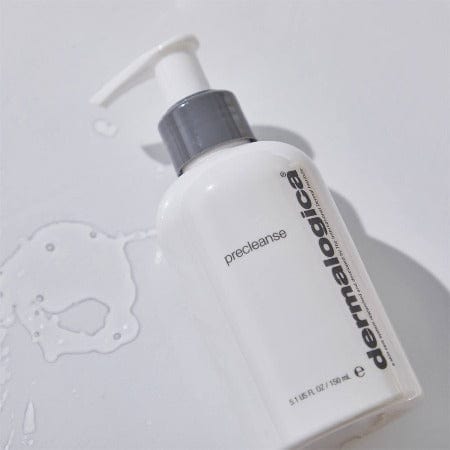Cleansing oils have become a staple in modern skincare routines, and for good reason. Whether you're battling stubborn makeup, excess sebum, or everyday impurities, these multitasking heroes gently dissolve it all without stripping your skin of its natural moisture. But with so many options on the market, finding the perfect cleansing oil can feel overwhelming.
In this guide, we’ll cut through the noise to bring you the best cleansing oils available, highlighting their benefits and offering tailored recommendations for different skin types and concerns. Whether you’re new to oil cleansing or looking to upgrade your routine, this no-nonsense guide will help you make an informed choice
Click on the links below to jump to that section:
- The three best cleansing oils for effective skincare
- Why choose a cleansing oil?
- Choosing the right cleansing oil for your skin type
- How to use cleansing oil effectively
- Addressing misconceptions about cleansing oils
Cut out the noise, explore the top products to try if you’re considering an oil-based cleanser
Discover the cleaning magic of natural oils, backed by dermatologists
Every complexion has different requirements, learn how to select a skin-loving product
Step-by-step guide on how to maximise the benefits of your skincare routine
Don’t make these mistakes – level-up your beauty regime
The Best Three Cleansing Oils for Effective Skincare
Ella & Jo Melt the Day Away Cleansing Balm
Ella & Jo's Melt the Day Away Cleansing Balm is a luxurious balm that melts into a nourishing oil to easily lift makeup, sunscreen, and sebum-trapped dirt while preserving skin balance. Enriched with nourishing grapeseed oil, squalane and raspberry seed oil, it supplies vital lipids and antioxidants leaving skin soft, supple, and radiant.


| Benfits: |
|---|
|
| Possible Downsides: |
|
Perfect For: Removing face makeup, dry, oily and combination skin
2. Kinvara Absolute Cleansing Oil
Kinvara Absolute Cleansing Oil is a gentle cleanser that brightens and nourishes the skin. Formulated with sunflower seed oil and camellia oil which are rich in antioxidants and fatty acids. The blend of oils effectively removes makeup, SPF, and dirt while replenishing moisture-retaining lipids. Ideal for dry skin types, it soothes and fortifies the skin barrier, leaving your skin feeling soft, smooth, and resilient. Even tough waterproof makeup is effortlessly removed without any greasy residue.


| Benfits: |
|---|
|
| Possible Downsides: |
|
Perfect For: Dry to combination skin or oily but not clog-prone complexions
3. Dermalogica Pre-cleanse Cleansing Oil
Dermalogica Precleanse Cleansing Oil is a gentle yet effective oil cleanser that removes makeup, dirt, and excess oil as the initial step in a double cleansing routine. It effortlessly breaks down tough waterproof makeup, SPF, and environmental grime. Ideal for oily and combination skin types, this cleanser helps balance oil production, prevent clogged pores, and loosen embedded dirt for subsequent cleansing. It’s ideal for very oily skin conditions.
Enriched with natural oils like apricot kernel, kukui nut and rice bran oil, it soothes and nourishes the skin, promoting softness, smoothness, and balance.

| Benfits: |
|---|
|
| Possible Downsides: |
|
Perfect For: Oily, combination, clog-prone and combination skin
Why Choose Cleansing Oil?
Using oil to wash your face might seem strange, especially if you have oily skin. But oil cleansing leans into your skin's natural chemistry. They help remove dirt and impurities while keeping your skin glowing and balanced.

The Science Behind Cleansing Oils
Cleansing face oils work based on a simple idea: "like dissolves like." The main cleanser ingredients in these oils usually include plant-based oils and emulsifiers. These oils help break down and dissolve excess sebum, makeup, sunscreen, and other oil-based dirt on the skin (and oil-trapped dirt). Emulsifiers help the oil mix with water, making it easy to rinse off without residue.
They are especially good for those with sensitivity, clog or acne-prone skin. Cleansing oils soften closed comedones, release trapped dirt and lift stubborn build-up without compromising the skin moisture barrier. If you have breakout or clog-prone skin, you'll want to prioritise non-comedogenic formulas like Dermalogica Precleanse Cleansing Oil.
Benefits of Using Cleansing Oil in Your Routine
Adding a cleansing oil to your skincare routine can be helpful for all skin types, they help lift heavy waterproof makeup, when micellar water just doesn't cut it; all without taking away your skin’s natural moisture.
- Stubborn makeup removal
- Nourishes and hydrates
- Suitable for sensitive skin
- Promotes a healthy skin barrier
Do Dermatologists Recommend Cleansing Oils?
While the efficacy of different skincare products will be forever in debate by dermatologists, cleansing oils are a logical way to pull impurities trapped amongst oily sebum. They're widely tolerated by various skin types including oily and sensitive complexions and they aren't stripping.
However, the main concerns are that they can clog pores or cause breakouts - opt for non-comedogenic formulas and always double cleanse (with a cream, gel or foaming cleanser as the second cleanser).

Always select a cleansing oil suitable for your skin type and patch-test before applying it to your entire face.
Cleansing Oils Vs Other Facial Cleansers?
Cleansing oils can provide a deeper clean than regular facial cleansers and they aren't going to leave our skin dry or tight. However, they aren't ideal for standalone use because they can clog pores or trigger acne.
You can use an oil cleanser or balm to remove makeup and impurities then follow up with a cream cleanser or gel face wash as your second cleanse for a deep and refreshing clean.
Choosing the Right Cleansing Oil for Your Skin Type
Oily, dry and sensitive skin has specific needs, what works for one may not work for another. Selecting the right formula can make or break your oil cleanse experience.
Are there any cleansing oils that hydrate the skin?
Facial cleansing oils aren’t directly hydrating because it’s typically a water-free formula. However, the lipid-rich plant oils help reinforce the moisture barrier without stripping your skin’s protective fats.
If you’re after an additional hydration boost, look for shea butter and grapeseed oil as these are pro-ceramide actives that support natural hydration levels.

What is the Best Oil for Clogged Pores, Acne and Oily Skin
It’s crucial to select a non-comedogenic formula if you have clog-prone or reactive skin. Oil cleansers reach deep into your pores to melt impurities. However, some ingredients like shea butter and coconut oil can block pores leading to bumpiness or acne.
Certain ingredients like evening primrose oil or rosehip are excellent for clarifying oily or acne-prone skin.
Makeup Removal for Sensitive Skin
Sensitive complexions should pay attention to fragrance-free formulations – even natural products can contain harsh plant oils which can cause irritation. Select dermatological skincare that has been sensitivity tested. Check for soothing extracts like camellia, chamomile, calendula extract or jojoba oil.
How to Use Cleansing Oil Effectively
Oil cleansers aren’t like water-based ones, there are some rituals you should honour. Explore our step-by-step guide and helpful tips.
- Massage your oil cleanser into dry skin (your hands should be dry too).
- Use circular motions to massage the oil cleanser for at least 60 seconds, paying attention to clog-prone areas and places where you experience greasiness or build-up (chin, nose creases, T-zone, etc.). You should feel your skin soften and release trapped dirt the longer you massage.
- Emulsify the oil by wetting your hands with warm water and rubbing this into the oil already on your face, this should create a milky consistency from the oil and water mixing together.
- Once the oil has fully emulsified, rinse off with warm water or wipe with a warm, damp face cloth.
- Follow-up with a cream cleanser for dry skin or a gel/foaming cleanser for oilier complexions.
- Pat your skin dry with a clean towel then apply your serums and moisturiser
The Role of Cleansing Oil in Double Cleansing
Double cleansing is a popular skincare technique that uses an oil-based cleanser first because it’s the most effective at lifting oily build-up and trapped grime. Then, a second, gel cleanser tackles any residue and leaves the skin feeling fresh and not stripped.
It might seem silly to use a cleanser to clean off another cleanser, but this method helps to deeply clean the pores without leaving a tight, dehydrated feeling, or causing breakouts.
Addressing Misconceptions About Cleansing Oils
Many people understandably worry that cleansing oils will exacerbate oily or acne-prone skin. However, cleansing oils that are made with non-comedogenic ingredients that actually help to unclog pores and lift impurities.
Another common myth is that cleansing oils leave a greasy residue. While some thicker oils such as castor oil or shea butter can be harder to remove, most new cleansing oils are formulated to rinse off with water. Look for emulsifying ingredients such as lecithin, olive oil, steric acid and glyceryl stearate. Try to follow the recommended application guidelines to avoid a greasy residue.
Frequently Asked Questions
How often should I use cleansing oil?
You can use cleansing oil every day - most prefer soluble cleansing in the evening to remove makeup and pollutants. You can use an oil cleanser in the morning but it’s not usually necessary. A cream cleanser is a good option for the morning.
Can cleansing oil replace my regular cleanser?
Most people experience problems from only using an oil cleanser. However, they can replace micellar water for makeup removal. Adding an oil cleanser to your routine can enhance radiance and softness but is best used as a pre-cleanse.
Is it necessary to use a moisturiser after using a cleansing oil?
Cleansing oils can make your skin feel hydrated and don’t give that tight feeling. However, it always smart to restore your moisture levels after cleansing, even warm water can dry out your skin. Use a hyaluronic acid serum to rehydrate.


